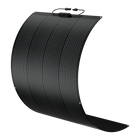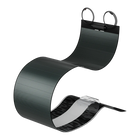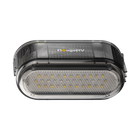How to Vent a Portable Air Conditioner without a Window?

A Portable air conditioner is undoubtedly enjoyable to use in the hot summer. The heat wave outside, but you got a cool air conditioner, and you won't feel the heat. Many people want to buy one portable air conditioner for their space to vent the heat, especially in a windowless attic, small disconnected rooms, and a stuffy basement.
The air conditioner unit is easy to move and store. They perform well at the same time. And they will work well if you decide to use the portable air conditioner in Indoor where home air conditioning has not been installed. But how can they vent the heat when cooling you?

- How do Portable Air Conditioners work?
- How to vent a portable air conditioner without Windows?
- Conclusion
- FAQ
How do Portable Air Conditioners work?
Portable air conditioner units work similarly to conventional air conditioning units. Portable air conditioners work by pulling hot air from the room into the unit. The motor inside the portable air conditioner then cools the air in order to circulate it throughout the room. The portable air conditioner also absorbs the warm air and excess moisture and pushes it through a hose and out the window. This is why you must learn how to ventilate a portable window air conditioner without Windows. In this article, you might find a way to vent your portable air conditioner.
How to vent a portable air conditioner without Windows?
When a portable air conditioner is turned on, it draws warm air from the room. It will then cool the air and send it back to your room. Meanwhile, air conditioners will have to expel hot air. If not ventilated, air conditioners can drain warm air back into your room, reducing its cooling effectiveness.
Here's how to ventilate a portable air conditioner without Windows.
- Vent through doors
- Vent through exterior walls
- Vent through Interior Wall
- Vent through the ceiling
- Vent through a chimney
1. Vent through doors
In addition to ventilating portable air conditioners through Windows, another of the simplest forms of air conditioner ventilation is through the doors. Open a slit for ventilation and let the hose out when using portable air conditioners. If you take it camping or on a trip, it's even more convenient. Simply unzip the tent and let the vent out.
However, the hoses of most portable air conditioners are usually not long enough. Therefore, you must place the portable air conditioner near the door. If placed far from the door, the hose may be unable to expel hot air outside.
2. Vent through exterior walls
Vent for portable air conditioner through exterior walls. If the room you are cooling has an exterior wall that leads directly to the outside, you can dig a hole in that wall that is large enough to provide adequate ventilation for all the hot air you are sucking out of the interior space by the hose.
It is a good idea to look at the structural plans and details of the building and use a stud finder to locate any supporting studs or beams before cutting holes in the wall. After all, you don't want to weaken the structure of the building at all, and you want to avoid cutting pipes or wires in the exterior walls.
Once you find a safe place, one that won't interfere with building systems or structures, you can carefully cut through the hole with a circular saw or similar tool. Be careful when cutting brick, stone, siding, and other exterior materials. Or the building structure might be destroyed.
3. Vent through interior walls
In addition to ventilation through the exterior walls, you can also ventilate portable air conditioning units through the interior walls. Suppose the windowless room you want to cool is near the center of the building and has no external walls. You can cut a hole in one of the inner walls and insert the device's ventilation hose into the other room. So the device will suck heat out of one room and pour it into another.
But this might be a problem: the second room gets hotter. So the other room should be an infrequently used laundry room, utility room, storage area, or garage.
4. Vent through the ceiling
If the wall method doesn't work well in your house, you can try to vent through the ceiling. In this case, you will need to install the air conditioner higher up in the room, perhaps on top of a sturdy metal shelving unit or bracket. Or you can elongate the exhaust hose so that the air conditioning unit can be placed on the floor, and the hose can be extended along the wall to the ceiling to be vented.
Use a ladder so you can get close to the ceiling. Carefully cut a hole in the ceiling, or remove all or part of the panel from the ceiling. In addition, you must monitor the humidity and temperature of the ceiling space to ensure that the heat and humidity levels are not too high. If it's too humid, mold can develop in the ceiling space.
5. Vent through a chimney
Another method is to vent your portable air conditioner through a chimney. You can vent the hot air through the chimney. However, it absolutely must be an unused chimney in an unused fireplace. Never attempt to ventilate a portable air conditioning unit through a functioning, working chimney or fireplace -- this is a considerable safety risk.
Before you drain the air conditioning unit into the chimney, especially if it has not been used for a long time, it is a good idea to check to ensure the chimney is clean and open.

Conclusion
I hope you can find out how to vent a Portable Air Conditioner without a Window in this article. Besides the methods above. Please remember you should put the portable air conditioner properly and ensure your hose works well. BougeRV has released its new portable air conditioner, you can feel the cool air in 15 seconds, and offers the hose with the product. And you may get assistance if you run into any issues.
FAQ
Is it worth buying a portable air conditioner?
For many homeowners and renters, portable air conditioners can be incredibly convenient and a cost-effective method to add some cool air to your living area. They can also be a lifesaver if your conventional air conditioner is broken — you can get them up and running quickly while you wait for repairs. To get a reliable portable air conditioner is vital too, check on BougeRV for out latest portable air conditioner.
Can portable air conditioners be used in a room without a window?
Yes, a portable air conditioner can be used in a room without a window. However, To get cooling, heat must leave the room. If the warm air doesn't drain out, it stays in your room, negating the cold air entering your space. So if you're going to benefit from it and get a cooler working or living space, it's vital that you air out your air conditioning in some way. Check the details method provided by BougeRV and get your points.
Where should a portable air conditioner be placed?
You will always need power, so make sure there is a plug outlet nearby. If possible, it is best to avoid connecting extension cords to air conditioning units. Portable devices (not window devices) work best if they are as close to the center of the room as possible.
What happens if you don't vent a portable air conditioner out the window?
If you don't vent a portable air conditioner out the window, the air conditioner will only circulate air in your room between cool and dry and hot and humid. Hot air can't get out, and cold air is created simultaneously, which heats your room, not cools it down.
How to keep the portable air conditioner clean?
1. Keep the air inlet/outlet clean and regularly wipe with a damp cloth.
2. When not used for a long time, the power should be unplugged, and the water should be drained.
Do portable air conditioners work in campers?
YES! Vent-less portable air conditioners can definitely keep you cool inside a camper. They won't, however, change the camper's internal temperature. They'll produce a pleasant wind that will assist you in cooling off by evaporating the moisture from your skin. Make your summer experience even better by using the BougeRV refrigerator to enhance your coolness.
Do portable air conditioners work in a tent?
YES! Unlike most room or portable air conditioners, the BougeRV portable refrigerator is not designed to cool an entire room to a set temperature. It is made for more personal comfort for you. Recommended using area is less than 3m³. So, it will work well in a tent.




































